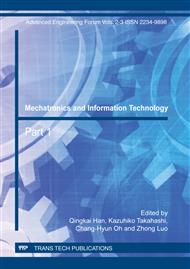p.24
p.29
p.33
p.39
p.43
p.48
p.53
p.57
p.63
Study on Acc/Dec Algorithm Based on Piecewise Polynomial in CNC
Abstract:
In order to improve the stability of feed movement in high speed CNC system, the feedrate planning algorithm based on piece-wise polynomial function was proposed. The flexible transition of feedrate was realized through maintaining linear continuous jerk. The principle of the proposed algorithm was introduced and the method to generate smooth motion profile based on the proposed algorithm was presented. The rapidity, stability and tracking accuracy of the feedrate planning algorithm to linearity, S curve and the proposed one were analyzed. The proposed algorithm is simple and it can be applied in acceleration/deceleration before interpolation in high speed feed movement to improve the stability of it. The proposed algorithm was applied in multi-contour high speed processing and the result indicated that it could improve the stability of large-scale parts motion.
Info:
Periodical:
Pages:
43-47
Citation:
Online since:
December 2011
Authors:
Keywords:
Permissions:
Share:
Citation:


